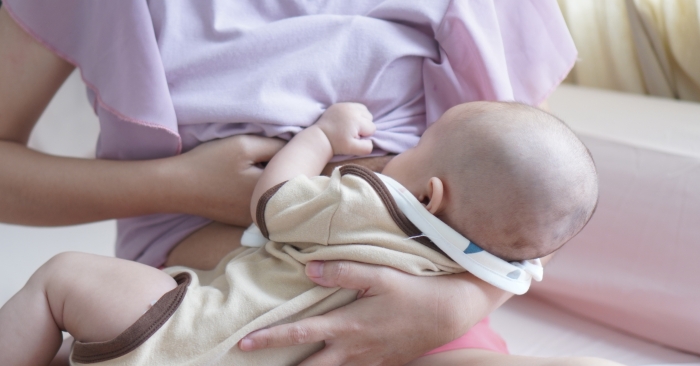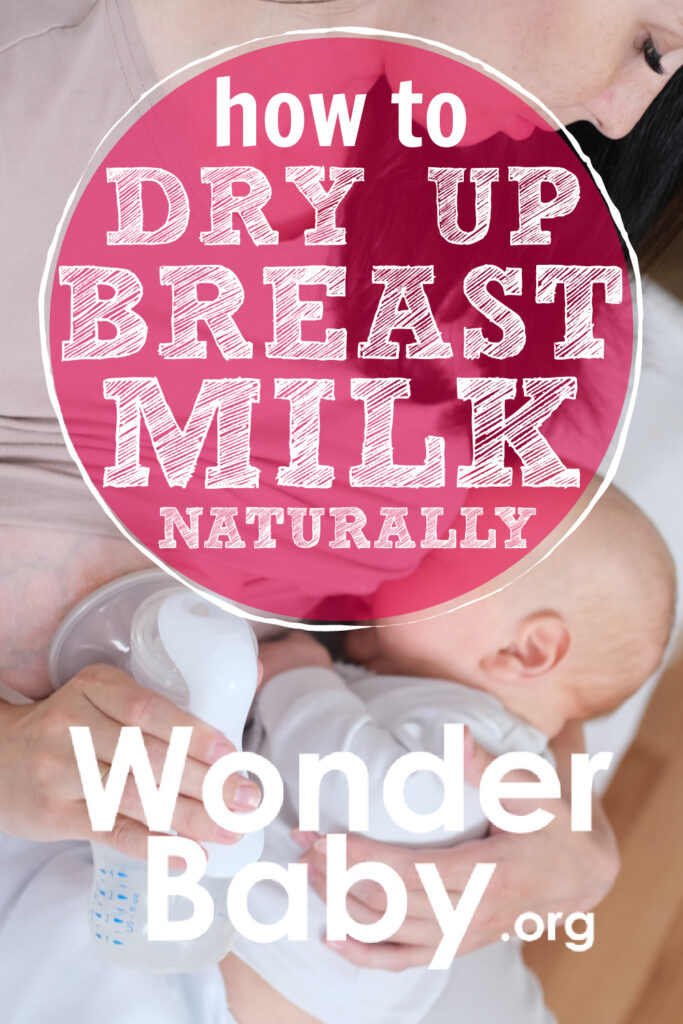How to Dry Up Breast Milk Naturally

- Breast milk dries up on its own when you stop breastfeeding or pumping.
- Stopping breastfeeding abruptly can cause sore breasts and mastitis.
- You can avoid mastitis by weaning from breastfeeding or pumping over several days or weeks.
- As your breast milk dries up, your breasts will feel less full, and you’ll produce less milk.
Whether or not a mother chooses to breastfeed her baby, she will eventually need to let her breast milk dry up. Mothers who choose not to breastfeed at all can let their milk dry up immediately after birth, while others may continue breastfeeding their children for several years.
While each mother’s breastfeeding journey is different, the process for letting breast milk dry up is mostly the same. Letting breastmilk dry up is a potentially uncomfortable process that can lead to mastitis or serious infection if done improperly.
When you’re ready to stop breastfeeding, knowing how to dry up breast milk naturally can help.
Will Breast Milk Dry Up on Its Own?
When it comes to producing breast milk, breast tissue is smarter than you may think. Breast milk supply changes based on demand. If your baby drinks more milk or if you pump more often, your breast milk production will increase. On the other hand, if you stop pumping or your baby drinks less, your milk production will go down.
If you stop breastfeeding, your milk supply will dry up on its own. However, quitting breastfeeding or pumping cold turkey can lead to painful breast engorgement or even a breast infection called mastitis.
How to Dry Up Breast Milk Naturally and Without Getting Mastitis

Unfortunately, the breast tissue does not just stop milk production as soon as you decide you are finished breastfeeding. Most mothers need to follow a slow weaning process to avoid engorged breasts and mastitis.
What is Mastitis?
Mastitis is a painful condition that is often caused by engorgement of the breasts. Swelling can clog the milk ducts and lead to infection and extreme discomfort.
Signs of mastitis include:
- Painful breasts
- Pain that gets worse during breastfeeding or pumping
- Red marks on the breasts
- Hard lumps on the breasts
- Fever and fatigue
Preventing Mastitis
Experts at La Leche League11. Thomas, S. M., & Reilly, J.. Mastitis and Sore Breasts. La Leche League International. 2023. https://llli.org/breastfeeding-info/mastitis state that mastitis often occurs in mothers who try to wean from breastfeeding too quickly. Try to use gradual weaning to reduce milk production and avoid potentially dangerous mastitis. The more slowly you can stop producing milk, the lower your risk of engorgement pain and mastitis.
A lactation consultant may be able to help you make a specific plan about how quickly you can stop breastfeeding and reduce your breast milk supply.
What to Avoid When Drying Up Your Breast Milk
There are a few things that should be avoided when trying to reduce your breast milk supply.
Breast Stimulation
When you are trying to stop milk production, breast stimulation should be avoided as much as possible. If you’re experiencing discomfort, you can express milk to relieve pain, but do not empty your entire breast.
Hot Showers
While it might sound like a soothing hot shower would make you feel better, it might actually make your inflammation and breast pain worse. Avoid hot showers while weaning from breastfeeding, especially if you already have engorgement or mastitis.
Breast Binding
Breast binding was once a popular way to help with decreasing milk production. However, more recent studies show that breast binding may increase the risk of pain and mastitis.
How Many Days Does It Take for Breast Milk to Dry Up?

Like all other things related to pregnancy, childbirth, and breastfeeding, every mother will have a different experience while trying to decrease milk supply.
Some mothers find that their breast milk supply dries up in just a day or two, while others must continue to hand express for weeks to relieve engorgement.
Research from the Cleveland Clinic22. Restarting breastfeeding: Relactation Tips. Cleveland Clinic. 2022. https://health.clevelandclinic.org/relactation shows that for mothers who choose not to breastfeed, it can take up to 21 days after birth for milk to completely dry up. For mothers who have been breastfeeding for long periods of time, it could take even longer.
While it can take several weeks for your milk supply to disappear completely, you should not be feeling pain or engorgement for nearly that long. Most mothers find that they start to feel more comfortable about a week after they decide to stop feeding their baby breast milk.
How to Tell That Your Breast Milk Is Drying Up Naturally
When your milk starts drying up, there are a few signs you may start to notice:
- Your baby gets frustrated while nursing.
- You produce less milk while pumping.
- Your breasts do not feel full, even with long breaks between nursing sessions.
Staying Comfortable While Weaning
Even a breastfeeding mother who weans from breastfeeding over a period of weeks or months may experience painful engorgement from time to time. Here are some ways to stay comfortable if this happens:
Ice Packs
If you are experiencing pain during weaning, a cold compress is one of the most effective ways to relieve discomfort. Applying cold packs can decrease swelling and inflammation, helping you feel better as well as reducing the risk of mastitis.
Some mothers choose to use frozen peas instead of ice packs, since they can be molded to form around the breasts.
Supportive Bra
Wearing a supportive bra can help manage breast engorgement and discourages the breast tissue from making more milk. You do not need an extremely tight bra, just choose one that fits well.
Cabbage Leaves
Cabbage leaves have been used to help with breast swelling and pain for centuries. Studies show33. Boi, B., KOH, S., & Gail, D.. The effectiveness of Cabbage Leaf Application (treatment) on pain and hardness in breast engorgement and its effect on the duration of breastfeeding. JBI Database of Systematic Reviews and Implementation Reports. 2012;10(20), 1185–1213. https://doi.org/10.11124/01938924-201210200-00001 that cabbage leaves applied to the breasts can reduce pain and prevent engorgement in nursing mothers.
Herbal Teas
Some herbal teas can cause lactation suppression. Herbs that can reduce milk production include: peppermint, sage, and jasmine. Use caution when consuming herbal teas, since some of them may interact with other medicines you are taking.
Gentle Massage
Using gentle massage can help reduce discomfort associated with engorgement and weaning. If you’re starting to feel uncomfortably full, gently massage the breast tissue and hand express just enough milk to relieve the discomfort.
Accepting the End of Breastfeeding
Drying up breast milk can trigger a lot of mixed emotions. On the one hand, mothers may feel relieved to have their bodies back to themselves. On the other hand, some mothers mourn the loss of breastfeeding. Many mothers fluctuate back and forth between the two feelings.
Mothers who have to stop breastfeeding earlier than planned or who feel a lot of pressure to continue breastfeeding when they don’t want to may have even more difficulty managing their emotions.
Speaking to a trusted friend or even a counselor can help. You may also want to take a few pictures of yourself breastfeeding your child, or keep a journal about your breastfeeding experience as a way to honor and remember the experience.

FAQs
Are there medications that can help dry up breast milk?
Several medications are known to decrease breast milk supply. Birth control pills, decongestant medications, and vitamin B supplements can suppress lactation and help dry up breast milk.
What can I do to manage the emotional discomfort that may come with drying up breast milk?
If you feel sad about drying up breastmilk, talk to a friend, lactation counselor, or healthcare provider about your feelings. Allow yourself to feel your emotions and accept them. Journaling, listening to music, and taking pictures breastfeeding your baby may also help.
Will wearing a tight-fitting bra help to dry up breast milk?
Wearing a supportive, snug bra may help you decrease your supply of milk faster. Choose a bra that is supportive and fits well, not one that is so tight that it causes discomfort.
Can I donate my breast milk while trying to dry up my own milk supply?
If you are trying to dry up your own supply, it is best to stop pumping milk for donation. If you continue to pump breast milk for donation, your breasts will continue to make milk faster.
What can I do if I experience a sudden increase in milk supply while trying to dry up breast milk?
Don’t worry if you experience a sudden increase in milk supply while trying to dry up your breast milk. Your milk production will fluctuate day by day, even while weaning from breastfeeding or pumping. Simply hand express until you are comfortable and continue on your weaning.
Is it possible to start breastfeeding again after stopping?
If you change your mind after allowing your breast milk to dry up, there is a chance you can teach your body to relactate. Relactation is a long process that requires a lot of work and patience, but it can be done.
Mothers who hope to begin producing breast milk again after stopping may need to talk to a lactation consultant for specific advice.
References
- Thomas, S. M., & Reilly, J. (2023, January). Mastitis and Sore Breasts. La Leche League International. https://llli.org/breastfeeding-info/mastitis
- Restarting breastfeeding: Relactation Tips. Cleveland Clinic. (2022, June 16). https://health.clevelandclinic.org/relactation
- Boi, B., KOH, S., & Gail, D. (2012). The effectiveness of Cabbage Leaf Application (treatment) on pain and hardness in breast engorgement and its effect on the duration of breastfeeding. JBI Database of Systematic Reviews and Implementation Reports, 10(20), 1185–1213. https://doi.org/10.11124/01938924-201210200-00001

The information WonderBaby provides is not intended to be, and does not constitute, medical or other health advice or diagnosis and should not be used as such. Always consult with a qualified medical professional about your specific circumstances.
Related Posts

Breastfeeding, Sleep
Sleep and Breastfeeding: A Comprehensive Guide for Nursing Moms
Many people assume breastfeeding and sleep training don’t go together, but it is possible to help your baby sleep better while continuing your breastfeeding journey.

Breastfeeding
Comfort Nursing: Pros, Cons, and How to Stop
Find out what comfort nursing is, when should you worry about it, and how to stop or limit your baby's comfort nursing (especially at night!).

Breastfeeding, Product Reviews
5 Best Breastfeeding Chairs for Nursing Moms of 2023
Whether you want a gentle rock, a smooth glide, or a cozy cuddle to soothe your baby to sleep, you’ll have your pick of the best breastfeeding chairs on the...